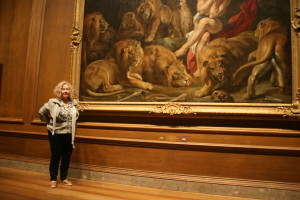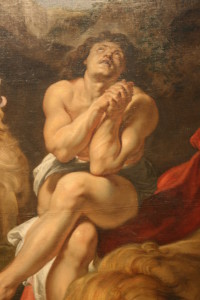Phase 1, I Begin the Journey
04 - 12
2013

The first thing I set out to do was to visit the famous painting, Daniel in the Lions’ Den, painted by Peter Paul Rubens between 1614 and 1616. My client sent me to the National Gallery of Art in D.C. for a day to study the painting and absorb its grandeur and its nuances. The Gallery has a copyist program that they sponsor, and artists may come in and set up their easels and start to work…, so they have no objections to copying the painting as no copyright exists on the original.
However, no paintings anywhere near the size of mine are allowed on the premises.
Although the reported size of the canvas was only approximately twice the size of my 5’ x 8’ canvas, I still can’t believe that when I look at me next to the painting.
I took multiple photographs of the painting. My strategy was to overlap sizes in order to study the content in every possible part. I halved it horizontally, and thirded it vertically. Then I took photographs of each of the different lions. I studied Peter Paul’s stroke work and where the brightest lights and darkest darks fell, and wrote it all down in my sketch book. I recorded his use of color and layering, his free use of brush strokes.
The next thing I did was to use my large-sized sketch book to draw the shapes of all the significant negative areas, like the area formed at Daniel’s feet with one lion, the space under a tail, under the standing lion, on the rock ledge in between, in the dip into the cave, and more. What good would it do me to get the faces and bodies but not in the right relationship to one another?
I recorded the colors, in particular, the inordinate use of the wonderful Old Master’s green that pervaded the browns, the shades of gold and burnt sienna on the lions, where the brightest highlights in the eyes fell, how the whiskers were—well, whisked in.
I particularly studied Daniel,
 the centerpiece of the Biblical story, at his moment of deliverance, when the King looked in and asked, “Daniel, was your God able to deliver you?” Even in the presence of the snarling lions, it is obvious this was not his moment of greatest fear, but was at a moment when he had a certain amount of peace and knew that the lions’ mouths were indeed shut, as the account goes. Emotion, attitude, and composition joined in this work of Rubens, and I had to study the emotional impact. I took particular note of the lighting and shadowing while I was there.
the centerpiece of the Biblical story, at his moment of deliverance, when the King looked in and asked, “Daniel, was your God able to deliver you?” Even in the presence of the snarling lions, it is obvious this was not his moment of greatest fear, but was at a moment when he had a certain amount of peace and knew that the lions’ mouths were indeed shut, as the account goes. Emotion, attitude, and composition joined in this work of Rubens, and I had to study the emotional impact. I took particular note of the lighting and shadowing while I was there.
It was a long day, sitting on the low bench and studying the painting from afar. Often I would near the painting for close-ups, but of course, my telephoto lens saved the day, and even so, I was elated to find out from the very friendly staff that the museum had a site which showed Daniel in his proper coloring. They gave me the link for using later. I also bought the museum book which has the painting in it to take home with me.
Usually you can’t keep me from the other paintings in a museum, but for this trip, I allowed myself only a few forays to nearby works.
My husband played tote and carry. For this project, I had no problems focusing—at least on one painting, even though I got to jump around within the painting.
This one view alone shows how packed the composition was, and yet how deftly the spaces and the overlapping of figures was handled. My biggest hurdle once I got home would be to transfer this complex drawing to the canvas and to edit what I knew would be inaccurate lines from a film projector—although the student who used it was quite talented, if you are not taught in the three dimensional techniques of the masters as I had been in Germany, you tend to flatten out what you see and extend the figures where they should have been foreshortened.
 Certainly in the extreme detail alone I had my work cut out for me. The hardest act an artist makes in the initial phases is to strip away all of the detail in his or her mind and take the figures down to their largest shapes and color. Think about it—you just can’t paint around a freckle or a hair, so it is useless to try setting that type of detail in in the beginning. However, Peter Paul gave his successors a road map in creating his wonderfully complex composition of organic shapes.
Certainly in the extreme detail alone I had my work cut out for me. The hardest act an artist makes in the initial phases is to strip away all of the detail in his or her mind and take the figures down to their largest shapes and color. Think about it—you just can’t paint around a freckle or a hair, so it is useless to try setting that type of detail in in the beginning. However, Peter Paul gave his successors a road map in creating his wonderfully complex composition of organic shapes.

Leave A Reply
You must be logged in to post a comment.